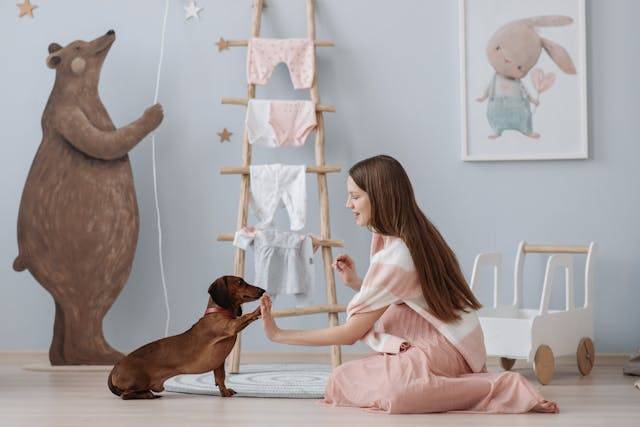How To Train A Pet With Basic Commands: Tips For Beginners
How do You Train a Pet?
Deprecated: preg_split(): Passing null to parameter #3 ($limit) of type int is deprecated in /home/dailwtkh/public_html/wp-content/themes/jannah/framework/functions/post-functions.php on line 863

Find out just how to simplify intricate commands, and use hand signals, coupled with looking for specialist aid for effective pet training.
It may be challenging to know how to start, but training your dog correctly is among the most essential and pleasing things you can do for your pet. Here we listed a few tips on how to train your pet.
Use positive reinforcement strategies
Most veterinarians believe using positive reinforcement is the best way to train a dog. Rather than punishing undesired actions, the emphasis of positive reinforcement training is on praising and rewarding appropriate ones.
Reward your dog whenever they act appropriately and obey your orders. The connection between excellent behavior and positive outcomes can be strengthened by rewarding it.
Be careful not to unintentionally reinforce undesirable behaviors. If your dog is misbehaving—saying hello too enthusiastically or barking at you—don’t respond or give in; doing so will only encourage more of the same. You should hold off on tending to them until they’re more composed.
Choose the best reward
Some canines are extremely food-motivated and would gladly take a sweet treat as a reward. For some, the choosiest snackers favor chewy, soft candies over crunchy, hard ones.
But some canines simply aren’t picky eaters. In such a situation, you might want to try out different forms of reinforcement, such as a brief game with a beloved toy or simply lots of love and attention.
Consistency is a Key
Maintaining a regular exercise routine is crucial. To train your dog consistently, you must be consistent in your approach. This means using the same words and tone every time you ask your dog to do anything.
Making sure that all members of your household understand the importance of this is equally crucial. Because dogs learn best when there is consistency, it would be counterproductive to let your dog on the couch occasionally but not at all if your partner does.
Train frequently yet with little effort
 It is significantly more beneficial to spread out shorter training sessions throughout the day rather than having one long one. The American Kennel Club states that dogs are more prone to become bored or irritated during sessions that exceed five minutes in length.
It is significantly more beneficial to spread out shorter training sessions throughout the day rather than having one long one. The American Kennel Club states that dogs are more prone to become bored or irritated during sessions that exceed five minutes in length.
Train your dog in diverse locations and with different interests to ensure he always sits when called. Because of this, they will be better able to adapt their commands to different settings. To illustrate, being aware that “sit” in one’s house is equivalent to “sit” in a crowded street.
Step-by-step Training
Starting small can be beneficial, especially when dealing with more complex behaviors such as “stay,” or when attempting to modify behavior.
Consider splitting behaviors into smaller sections. For example, if you’re teaching your dog to “come,” praise and treat them when they take even a single step towards you. If your puppy accepts it, you can add steps and work up to the complete behavior.
Dogs learn paw handshakes from people. The individual instructs the canine in the art of the paw handshake.
Add some joy to it
You and your dog should enjoy training. Keep a cheerful attitude and try new things to keep things intriguing. For instance, adding short play sessions between repeats.
To increase the obedience training that you already provide for your dog, you may also try teaching him some tricks. As human beings, we naturally react more actively when we see a dog roll over than when we see a dog simply sit down. Our dogs pick up on this interest and end up enjoying performing tricks for us.
When it comes to training, it is easy to achieve the final goal, but it is essential to remember to offer your dog praise for even the smallest accomplishments that they make while being trained.
Appreciate the little things
Regardless of how minor an improvement your dog makes, you should constantly make sure to recognize and reward it. It is important to know and reward success toward training goals to retain motivation on both your and your dog’s part. However, it is easy to lose perspective of the bigger picture when you are focused on the specifics of something.
Add exercise into daily routines
Incorporating training into your pet’s routine consistently makes it much simpler to fit in a number of shorter sessions. Before taking your dog for a walk, feeding them, or playing with them, make sure they are relaxed or prepared to respond to another order.
Use your hands
Dogs simply do not have the verbal capacity that humans do. Some dogs are more receptive to visual cues than vocal commands, therefore it may be helpful to use both verbal and nonverbal cues while training them.
See a professional dog trainer or enroll in a training course
Seek assistance by contacting a dog trainer or enrolling in a training class. Expert dog trainers can help you and your puppy quickly learn new tricks because they have years of experience in the field. Since they have likely dealt with a wide variety of challenges during their careers, they should be able to provide insight into potential solutions.
When selecting an instructor, spend some time investigating. Make sure they employ positive reinforcement tactics. Read a lot of reviews or get recommendations if possible.
Wrap Up:
Training your pet, particularly a canine, may be a rewarding experience that improves your attachment and ensures a strong bond. You can appropriately show your pet’s desired activities by using positive encouragement, selecting the appropriate benefits, maintaining uniformity, and using quick, consistent training sessions. Eliminating complex commands, making training more pleasant, and recognizing minor improvements are all important.
Additionally, using hand signals and seeking expert assistance, when necessary, might improve the training process. Keep in mind that perseverance and commitment are critical to good pet dog training!



